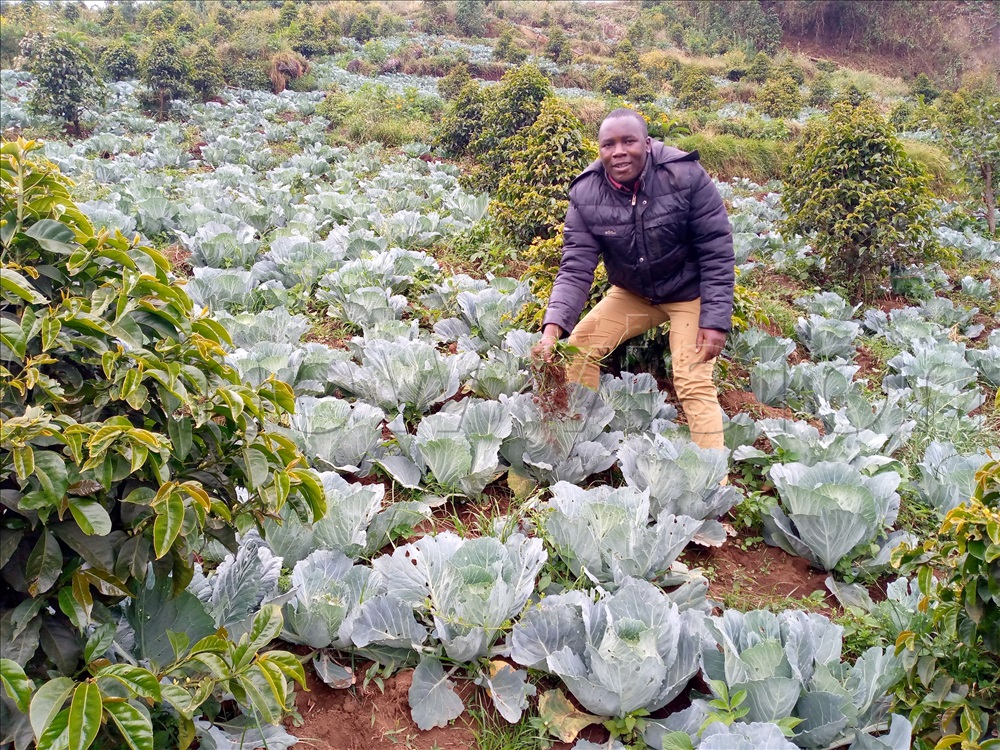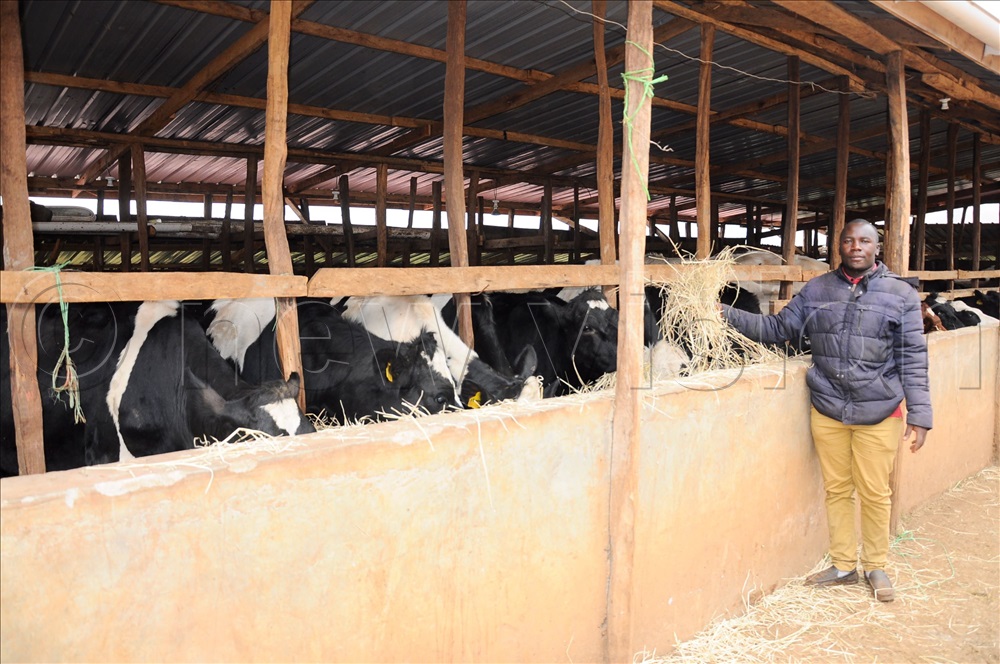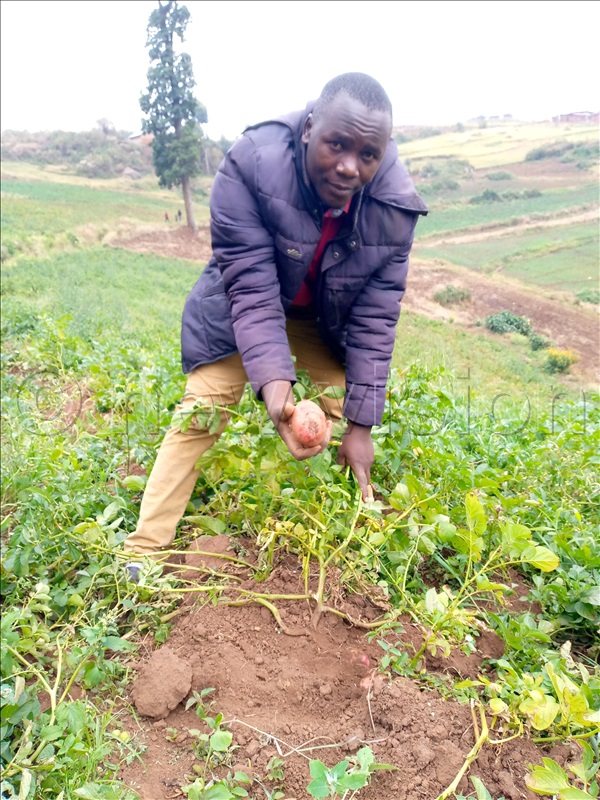By Umar Nsubuga
If you ask Cassim Wojambuka’s neighbours for directions to his home, most of them will not know what you are talking about.
However, if you ask for Young boss, any resident of Teryet village in Kapchorwa district will straight away direct you to his home.
Wojambuka practices coffee, cabbage and Irish potato growing, though his main farming enterprise is dairy farming.
Wojambuka is the only leading dairy farmer in Teryet. At the youthful age of 32, he has flourished where other farmers in his village have failed.
He walks briskly as he watches over a herd of cattle eating hay at the farm.

“I decided to invest in cattle keeping because I considered it safe,” he says as he waves his herding stick.
Martin Cherop, a resident says many people have learnt so much from the young man’s farm and this has made it easier for many to admire him in the area.
His project sits on 25 acres — the coffee plantation and cabbages on 10 acres, Irish potatoes on six acres while the cattle are on zero grazing and free range on the remaining acres.
How he started
Wojambuka says he picked interest in farming when he was still a child. He grew up in Mbale and he used to go to Kapchorwa where his family and relatives were practicing subsistence farming.
When he joined secondary school, he started growing cabbages, tomatoes, and onions for home consumption and for selling purposes, on the one acre of land his father had given him, he used to sell some products to friends and some neighbours.
“After completing O’level, I fell in love with cattle. Using savings from the vegetables I used to sell (sh500,000) I bought a cow,” Wojambuka says, adding that the cow produced more than four calves and it was a good start.

In 2013, Wojambuka did not bother looking for a job. Instead, he decided to set up his farm in Teryet.
Wojambuka had planted onions on one acre that he rented at sh150,000 and also had planted an acre of cabbages on the land his parents had given him.
“I used the sh500,000 on both projects and I earned sh2m,” he says.
Wojambula says he decided onions because they were marketable in Kapchorwa and the surrounding areas.
“When I decided to do commercial, I worked so hard. I worked from morning to evening with little rest,” he says.
He says growing onions was easy because he had learnt the best agronomic practices from people who were doing commercial.
Using the sh1.5m I earned from cabbages and onions, I bought another acre in addition to two others at sh1,000,000,” Wojambuka says.
He says he grew onions on one acre and Irish potatoes on two acres. To avoid losses, he applied modern practices such as planting high-quality seeds and applying fertilisers to the land.

During that time, the garden was doing well and the cow was giving me milk and the calves. Currently, he gets 100 litres of milk daily. Apart from giving him milk, the cows give him manure for his gardens.
Wojambuka sells the milk at sh1,000 per litre, earning him an average of sh400,000 daily. Most of the milk is bought from the farm by big hotels and restaurants in Kapchorwa town.
Asked about the expenditure and inputs, Wojambuka says the biggest expense he incurred in starting the farm was sh20m, which he used to construct the cattle shed.
Dairy
There are 25 cows but only 10 are the milking cows. From these, he gets 100-120 litres per day.
“I get sh100,000 per day before deducting the expenses,” he says.
This enterprise also contributes dung and urine to get organic manure, which is applied in the crop plantations.
According to Wojambuka, the average cost of a litre of milk is sh800 during the wet season and sh1,000 during the dry one.
“My buyers are big restaurants and hotels in Kapchorwa,” Wojambuka says.
Wojambuka says he concentrated on the hybrids because they mature faster and attract a higher price than the traditional breeds.
From milk, he earns around sh3m in a month, but he also spends money on veterinary doctors to monitor and vaccinate his cattle, especially when they are sick, and also on the fuel he puts in while taking the milk to town.
Feeding the cows
“In addition to grazing in the paddocks, I feed them on silage and hay,” he says.
As a supplement, he buys molasses at sh120,000 per drum of 250 litres and adds it to the grass.
This can last him a month. In order to give enough water to the cows, he stored water in tanks. He uses a pump to draw water from the tanks to protect the water from being contaminated which can happen if the cows directly drink from the drums.
He says the regular expenses are on workers and feeds that cost him sh150,000 weekly.
“I spray every two weeks at sh50,000-sh70,000. I also call a veterinary doctor to check them once in two months,” he says.
Among the services Wojambuka praises veterinary doctors for is artificial insemination, which he says has improved the breeds on his farm.
Irish potatoes
Wojambuka says Irish potatoes are a seasonal crop that matures in three months. After three months, the crop is ready for harvest.
Wojambuka says a combination of fair weather and good agronomic practices, he earns sh10-12m from an acre.
“I get about 100-200kg bags from an acre of land. I sell a bag bewteen sh60,000-sh90,000,” he says.
Cost of production
Wojambuka says the seed is the most important variable in the enterprise. Irish potato seeds are usually smaller in size than what is sold in the market.
A 100kg bag of seed usually goes for sh200,000 and an acre requires five bags or sh1m. Land preparation takes sh60,000 per acre when using oxen for first ploughing.
Before the Irish potato seed material is planted, a farmer should apply fertiliser. A 50kg bag of fertiliser goes for sh120,000 and an acre requires three bags.
Planting costs sh100,000 per acre.
“Three weeks after planting, the Irish potatoes would have germinated and the garden is due for weeding,” he says.
Wojambuka says attention is crucial as it gives room for the plants to yield more, spraying using a fungicide protects the plants from possible infections by fungal diseases.
A kilogramme of effective fungicides on the Ugandan market goes for about sh35,000.
A kilogramme mixed in water can spray an acre of Irish potatoes. The labour for the fungicide application is usually sh50,000 per acre.
“During harvesting time I require a labour force of 7-10 people per acre. Each of them is paid sh5,000 per 100kg bag they fill,” he explains.
Wojambuka has no formal background in the Irish potato enterprise, other than curiosity and constant consultation from farmers who have been engaged in the enterprise longer than him.
Best post-harvest handling practices
Because Irish potatoes are a perishable crop, Wojambuka discourages the use of sharp implements, such as hoes, which are bound to bruise them.
“The danger of packing cut Irish potatoes is that it makes them rot,” he says.
It is a prudent practice for the handlers undertaking the harvest to use their hands to reduce damage to the potatoes.
Cabbages
Currently, he has 15,000 hybrid cabbages on the 10-acre piece of land.
Wojambuka says he decided to start a cabbage project because the crops are an important vegetable in their region and it’s an emerging money crop.
He says there is a big market for cabbages.
“Customers come from Kenya and Sudan when I realised that cabbages can be eaten as a salad, boiled alone or mixed with a sauce, I didn’t hesitate”, he says.
At the peak of the season, a medium-sized cabbage costs between sh500 and sh1,000 at the farm. However, during the dry season, they go for about sh1,500-sh2,500.
An acre takes around 15,000-20,000 cabbages, which makes an average sh7m-sh10m, depending on the season. Average costs per acre are sh5m, including buying seeds.
According to Wojambuka, a well-drained soils enhance quick germination within 21-25 days before transplanting.
He says one needs to prepare the ground with organic materials to act as fertilisers, before thinking of transplanting.
Manure is one of the essentials for proper growth in the nursery bed, therefore, basal fertilisers, such as DAP, insecticide and fungicide give a healthy seed.
This is backed up with fine soils mulched with dry grass before water is applied using a watering can. Do not flood the seeds.
Uproot the seedlings with roots. This ensures high chances of survival and better establishment in the main garden. Watering the seedlings one hour before transplanting moistures the soil for their survival.
He says when you come up with the challenge of the diseases, which include black rot, black leg, downy mildew and white rust, which attack both the leaves and roots, you can manage them quickly.
“Cabbages are ready at 65-75 days after planting. At this stage, they are firm with fully formed heads and weighing between 2kg-4kg,” he explains.
From an acre of cabbage, Wojambuka earns between sh4m and sh7m, depending on the season.
Coffee
Wojambuka started planting coffee in 2020. After undergoing training for five months and acquiring experience in coffee growing, he discovered that organic farming was not only a better approach to coffee growing, but also a cheap practice as a farmer did not have to spend on pesticides and fertilisers, which could be made locally using organic materials.
He got coffee seedlings from Mbale.
They were 4,500 seedlings, each costing sh1,000 and they are all doing well.
Values of the farm
According to Wojambuka, they have managed to sustain the farm’s legacy by respecting the core values on which it was established.
“Excellence is one of the team’s core values and we achieve it through a monitored evaluation system and client feedback,” he says.
He says other core values of the farm include integrity, trust and confidence, affordability of products, value for money, good customer service and community empowerment.
We also do trainings and sensitisation programmes for farmers, in order to create awareness and inform the public on how to shift from cattle rearing to profitable farming ventures,” Wojambuka says.
Advice
Advice to youth Wojambuka advises youth, especially those engaged in unreliable businesses, to switch to farming because it is productive and profitable.
Social impact
Wojambuka says he employs youth, some of whom have since set up their own farms. Wojambuka’s farm is also a demonstration centre where others can learn from. His highest-paid worker earns sh250,000 a month, while the lowest receives about sh150,000.
Challenges
Wojambuka says the weather has become erratic, which has made farming costly. He explains that much as he applies irrigation, there are times when the water supply from Atari Falls is too low to serve his farm sufficiently.
“Initially, we used to depend on rainwater, but today, without irrigation, one is not guaranteed a good harvest,” he says.
Wojambuka decries fake farm inputs, especially seeds and chemicals on the market.
“To avoid falling victim to these, I spend an extra coin to get inputs from Kenya,” he explains.
Getting the required skilled labour is also a challenge, Malinga says, because he is producing for export, he has to have employees with specialised skills.
“For example, for a tractor driver, you need an experienced one, yet this takes time and is expensive”
“Milk prices are also still very low at only sh1,000 per litre, yet feeding a cow is becoming more expensive,” he says.
He says that for a farmer to earn a decent profit, a litre should go for at least sh1,500 at the farm.
Achievements
Looking back, Wojambuka says he cannot imagine that he was able to achieve a string of tangible assets in such a short time. After 10 years of the enterprise, he has been able to construct a training centre, buy a lorry which transports his produce, and expand to 25 acres.
He has been able to pay tuition fees for himself and three of his young siblings.
Plans
“My dream is to make my farm one of the biggest and best dairy farms in Kapchorwa and also start making several dairy products such as ghee and yoghurt.
He does not regret taking on farming, Wojambuka plans to start a company in Teryet, and expand his dairy farm in Kapchorwa into a training centre for both students and farmers. His vision is to have more than 200 head of cattle.
He says farming saved him from buying food for his parents and family.
“Since I went into farming, the income and nutrition status of my family improved”.
“I wish to also promote farming for export by empowering a bigger section of the community with knowledge in commercial farming and the best farm practices,” he says.
Wojmbuka dreams of growing Teryet mixed farm into a model one in 5 years’ time.
What others say
Jackson Cherop, a resident
Wojambuka has expanded his knowledge throughout. We now know about dairy farming we appreciate it. He has made practising farming a serious business.
Joseph Munyera, a resident
I have been a farmer for over 20 years, but it is from Wojambuka that I have learnt the best practices in farming. I will not be suffering any more losses.
Jennifer Chebet, a friend
I was growing only onions, but when I went to Wojambuka, he gave me knowledge free of charge and now I am expanding. He wants us to start so that we do not go to his farm to steal.





